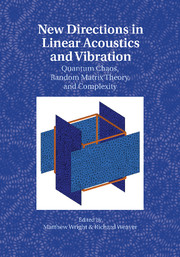Book contents
- Frontmatter
- Contents
- Foreword by Michael Berry
- Introduction
- 1 The Semiclassical Trace Formula
- 2 Wave Chaos for the Helmholtz Equation
- 3 The Unreasonable Effectiveness of Random Matrix Theory for the Vibrations and Acoustics of Complex Structures
- 4 Gaussian Random Wavefields and the Ergodic Mode Hypothesis
- 5 Short Periodic Orbit Theory of Eigenfunctions
- 6 Chaotic Wave Scattering
- 7 Transfer Operators Applied to Elastic Plate Vibrations
- 8 Mesoscopics in Acoustics
- 9 Diagrammatic Methods in Multiple Scattering
- 10 Time-Reversed Waves in Complex Media
- 11 Ocean Acoustics: A Novel Laboratory for Wave Chaos
- 12 Mesoscopic Seismic Waves
- 13 Random Matrices in Structural Acoustics
- 14 The Analysis of Random Built-Up Engineering Systems
- References
- Index
10 - Time-Reversed Waves in Complex Media
Published online by Cambridge University Press: 05 October 2010
- Frontmatter
- Contents
- Foreword by Michael Berry
- Introduction
- 1 The Semiclassical Trace Formula
- 2 Wave Chaos for the Helmholtz Equation
- 3 The Unreasonable Effectiveness of Random Matrix Theory for the Vibrations and Acoustics of Complex Structures
- 4 Gaussian Random Wavefields and the Ergodic Mode Hypothesis
- 5 Short Periodic Orbit Theory of Eigenfunctions
- 6 Chaotic Wave Scattering
- 7 Transfer Operators Applied to Elastic Plate Vibrations
- 8 Mesoscopics in Acoustics
- 9 Diagrammatic Methods in Multiple Scattering
- 10 Time-Reversed Waves in Complex Media
- 11 Ocean Acoustics: A Novel Laboratory for Wave Chaos
- 12 Mesoscopic Seismic Waves
- 13 Random Matrices in Structural Acoustics
- 14 The Analysis of Random Built-Up Engineering Systems
- References
- Index
Summary
Time-reversal invariance is a very powerful concept in classical and quantum mechanics. In the field of classical waves (acoustics and electromagnetism), where timereversal invariance also occurs, time-reversal mirrors (TRMs) may be made simply with arrays of transmit–receive antennae, allowing an incident broadband wave field to be sampled, recorded, time-reversed, and re-emitted.
TRMs refocus an incident wave field to the position of the original source regardless of the complexity of the propagation medium. TRMs have now been implemented in a variety of physical scenarios from gigahertz microwaves to megahertz ultrasonics and to hundreds of hertz in ocean acoustics. Common to this broad range of scales is a remarkable robustness exemplified by observations at all scales that the more complex the medium (random or chaotic), the sharper the focus. A TRM acts as an antenna that uses complex environments to appear wider than it is, resulting, for a broadband pulse, in a refocusing quality that does not depend on the TRM aperture.
TRMs open the way to new methods for signal processing in imaging, detection, and telecommunications. TRMs have applications in ultrasonic therapy, medical imaging, non-destructive testing, telecommunications, underwater acoustics, seismology, sound control, and even home automation.
Introduction
The evolution of electronic components enables today the building of TRMs that make a wave relive the steps of its past life. These systems exploit the fact that in a majority of cases the propagation of acoustic and electromagnetic waves is a reversible process.
- Type
- Chapter
- Information
- New Directions in Linear Acoustics and VibrationQuantum Chaos, Random Matrix Theory and Complexity, pp. 146 - 168Publisher: Cambridge University PressPrint publication year: 2010



